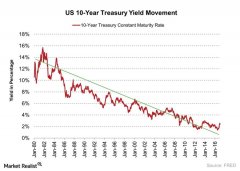Bond yield rates
Probability of Rate Hike Is Rising: What It Means for Investors PART 2 OF 4
Interest rate and bond yield
The ten-year US Treasury yield was close to its one-month high of 2.6% on March 13, 2017, amid expectations of a rise in the Fed’s key interest rate on March 15, 2017. The Treasury yield of the 30-year (TLT), ten-year, and two-year bonds are inching towards highs due to expectations of a hawkish stance from the Fed.

In the previous part of this series, we discussed that the probability of a rate hike increased sharply last week. When interest rates gradually increase in the economy (SPY) (QQQ), investors generally look for short-term duration bonds (SHY). During a gradual rate hike scenario, bond prices fall, and the yield, which moves in the opposite direction as bond prices, rises.
Bond bull market
The bond market has shown a huge rally in the last 35 years. The technical indicators are also showing that the 35-year bond bull market will see its end. The movement of the ten-year Treasury yield is proving that. In the last three decades, the ten-year Treasury yield (TLT) (SHY) has been sloping downward, which shows that the bond prices (BND) have rallied sharply during this period.
The prolonged lower interest rate also helped this movement. Lower interest rates artificially boosted various asset prices. Many fund managers believe that this bond bull market is ending. The present rising yield is mainly due to expectations of a hawkish stance from the Fed. David Tepper, billionaire investor and the founder and president of Appaloosa Management, recently said in an interview, “If we’re short US bonds, we’re betting on a stronger economy here. That’s the bet, listen bonds are really hard to own. The yields are really low.”